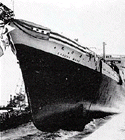Japanese aircraft carrier Taiyō
| Taiyō at anchor | |
| History | |
|---|---|
| Name: | Kasuga Maru |
| Namesake: | Kasuga Shrine |
| Operator: | Nippon Yusen (NYK) |
| Builder: | Mitsubishi Shipbuilding & Engineering Co., Nagasaki, Japan |
| Laid down: | 6 January 1940 |
| Fate: | Transferred to the Imperial Japanese Navy, 1940 |
| Namesake: | Goshawk |
| Launched: | 19 September 1940 |
| Acquired: | 1940 |
| Commissioned: | 2 September 1941 |
| Renamed: | Taiyō (大鷹) |
| Fate: | Sunk by the submarine USS Rasher off Cape Bolinao, Luzon, 18 August 1944 |
| General characteristics | |
| Class and type: | Taiyō-class escort carrier |
| Displacement: |
|
| Length: | 180.2 m (591 ft 4 in) (o/a) |
| Beam: | 22.5 m (73 ft 10 in) |
| Draft: | 7.7–8.0 m (25.4–26.25 ft) |
| Installed power: |
|
| Propulsion: |
|
| Speed: | 21 knots (39 km/h; 24 mph) |
| Range: | 6,500 or 8,500 nmi (12,000 or 15,700 km; 7,500 or 9,800 mi) at 18 knots (33 km/h; 21 mph) |
| Complement: | 747 |
| Armament: |
|
| Aircraft carried: | 23 (+ 4 spares) |
The Japanese aircraft carrier Taiyō was one of four ocean liners converted to escort carriers by the Imperial Japanese Navy (IJN) during World War II. She was the lead ship of her class of three carriers. She was initially used to transport aircraft to distant air bases, and for training pilots to land on conventional aircraft carriers. The ship was later used to escort convoys of merchant ships until she was sunk by an American submarine in 1944.
Civilian service
The Kasuga Maru (春日丸) was a 17,100 long tons (17,400 t) Japanese ocean liner owned by Nippon Yusen Kaisha. When first launched, this ship was named after an important Shinto shrine.[1]
The ship was built by Mitsubishi Shipbuilding & Engineering Co. at Nagasaki, Japan. Work on the Kasuga Maru was completed in 1939.[2] The vessel's pre-war design anticipated passenger service; but when work was completed, the onset of war resulted in different priorities.
The 17,150-ton vessel had a length of 591 feet (180 m), and her beam was 73 feet (22 m). The ship's steam turbines and twin screw propulsion produced an average speed of 18-knots.[2] It was laid down in January 1940 and launched in September of the same year.

Military service
In February 1941, before she was completed as a passenger ship, Kasuga Maru was requisitioned for transportation of military stores and personnel.[3] In 1942, its sister ship Yawata Maru was recommissioned as the Japanese aircraft carrier Unyō and the Nitta Maru was recommissioned as the Japanese aircraft carrier Chūyō.[4]
After she completed a few personnel transport voyages, it was decided to convert her to an escort carrier. The conversion took place in Sasebo from May–September 1941. Her flight deck measured 150 m × 23 m (492 ft × 75 ft) and was equipped with two elevators. With no island, catapults or recorded arresting gear, Kasuga Maru was classified as an auxiliary carrier. On 31 August 1942, she was renamed Taiyō (大鷹, “goshawk”) and reclassified as a warship. The recorded lack of arresting gear on the Taiyo and her sisters has been disputed as, while photographic evidence is lacking, the Taiyo had aircraft which required arresting gear to land aboard a carrier.
Taiyō was used primarily for flight training and aircraft transport. She was torpedoed and hit by United States Navy submarines on several occasions: on 28 September 1942, south of Truk by USS Trout, then on 9 April 1943 by USS Tunny and on 24 September 1943 by USS Cabrilla. Each time, she was repaired and put back to service. During her career, Taiyō's anti-aircraft armament was upgraded several times. On 18 August 1944 off Cape Bolinao, Luzon, while escorting convoy Hi-71 headed for Manila, Taiyō was hit by a torpedo fired by the submarine USS Rasher. The hit caused the carrier’s avgas and oil tanks to explode, and Taiyō sank in 26 minutes, with few survivors.
See also
Notes
- Dr. Bak József et al. (1984): Hadihajók. Típuskönyv. Zrínyi Katonai Kiadó. ISBN 963-326-326-3
- Ponsonby-Fane, Richard Arthur Brabazon. (1935). The Nomeclature of the N.Y.K. Fleet. Tokyo : NYK. OCLC 27933596
- Jordan, Roger. (2006). The World's Merchant Fleets, 1939: The Particulars And Wartime Fates of 6,000 Ships. Annapolis: Naval Institute Press. ISBN 978-1-59114-959-0; OCLC 150361480
- Tate, E. Mowbray. (1986). Transpacific steam: the story of steam navigation from the Pacific Coast of North America to the Far East and the Antipodes, 1867-1941. New York: Cornwall Books. ISBN 978-0-8453-4792-8; OCLC 12370774
- Rekishi Gunzō, History of Pacific War Vol.64 Mutsuki class destroyer, Gakken (Japan), May 2008, ISBN 978-4-05-605091-2
References
- ↑ Ponsonby-Fane, Richard. (1935). The Nomeclature of the N.Y.K. Fleet, p. 50.
- 1 2 Jordan, Roger. (2006). The World's Merchant Fleets, 1939: The Particulars And Wartime Fates of 6,000 Ships, p. 258.
- ↑ Haworth, R.B. Miramar Ship Index: ID #4048210.
- ↑ CombinedFleet: Taiyō class, Imperial Japanese Navy.
External links
- Imperial Japanese Navy Page
- Carriers of World War II
- http://candamo.iespana.es/japon/tecnicas/itaiyote.htm
- Naval Weapons of the World
- Warship.get.pl
- http://homepage3.nifty.com/jpnships//showa1/showa1_oshu_nyk.htm